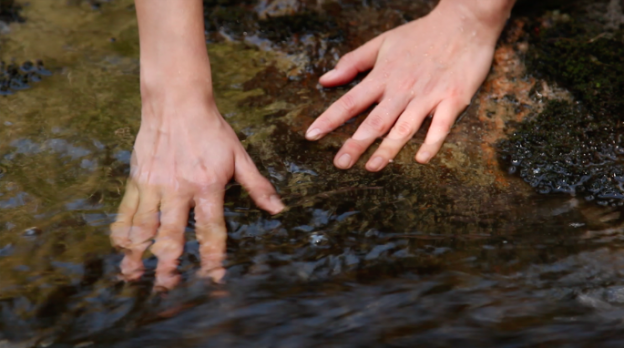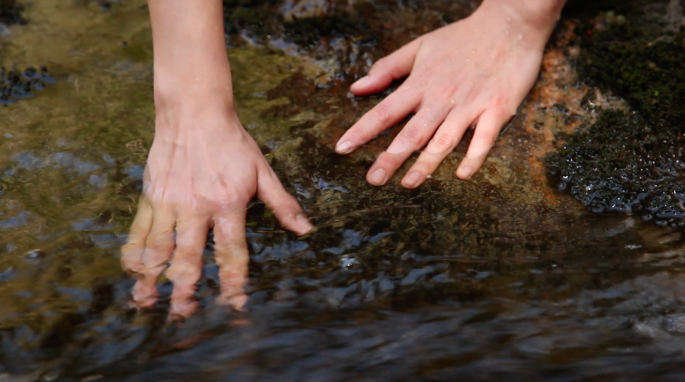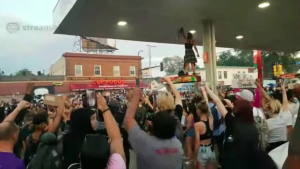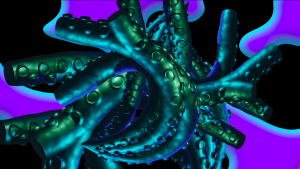
with WATER
a video by TANYA LUKIN LINKLATER
Water walkers. Walk. 550 miles. Meditating. Praying. Thinking. Talking. Laughing. Crying. Remembering the 134 missing and/or murdered Native women who have been found in the Red River of the North. From Breckenridge, Minnesota to Lake Winnipeg, Manitoba. The spirit shadows of the women walk with us. Reminding us that we are alive. We made it. No matter what the struggle has been, we made it. Some of them didn’t. Some we don’t know whether they made it or not. Others survived but must live with the trauma. Those of us walking reverberate with loss, sorrow, and hope.
Internationally, it is estimated that over five thousand Native women are missing and/or murdered. This number does not include the women from Mexico and Central America who are also missing and/or murdered. But from the northern half of the continent alone, the numbers climb. Typed, single-spaced, their names cover ninety pages of 8 ½ by 11 inches paper. Ninety pages, single-spaced.
As we walk the Red River in August of 2019, the lives of our sister women weigh heavy on our hearts and spirits. As survivors of domestic violence, sexual assault, attempted murder, we all are all too aware that we, individually and collectively, could easily join that list: our names could be added to that stack of ninety pages. But we live. Today, we are alive. So, we walk in the shadow of their sorrow.
There are many names for the grief we carry. Ambiguous grief. Sudden, traumatic death grief. Collective grief. Intergenerational trauma. Historical trauma. Someone we care about is gone. Sometimes that “gone” is disappearance. Sometimes that “gone” is death. Taken. Displaced. Removed. Disappeared. Words that in the midst of grief have no meaning. There are only the feelings of hollowness, rage, and sorrow that consume the soul. And the shadow of that loss lingers, long after those waves of feeling subside.
Grief tends to be felt in stages: shock, denial, bargaining, depression, acceptance. But they never emerge in a nice, predictable order. Rather, they are a chaotic roil of emotion. A person, and the collective, needs to travel through each stage in order to heal fully from the loss. Without the opportunities to resolve each stage, a person, or a collective, can get stuck in a particular wave of emotion.
With ambiguous grief, we don’t know if the person is just gone, or is truly missing. We can live in the stages of shock and denial, not knowing if the ones who are gone will someday return, or if they are dead. We can bargain endlessly: If they return I will never be mean to them again, I will never drink again, I will never___. Fill in the blank. We imagine the worst. We bargain for the best. The shadow of their memory haunts us daily. We long for their return. We leave important events undone. Holidays go uncelebrated as a heavy cloud shrouds the days. We forget where we put things, can’t find things we need. Everything is misplaced, out of place. Another people’s happiness annoys us. We rage at inconsequential happenings. All we want is for them to return. If that hope disappears, we long for closure. Anything to let us move out of the darkness. We might stop bargaining for their return, but instead bargain for any answer that will explain how the world was turned upside down, inside out.
A sudden traumatic death—murder—throws us into unprepared grief. In these instances, the order of the universe is thrown off. When someone is diagnosed with cancer, we can prepare for them to leave us. In the natural order of the universe, grandparents get old and die, teenagers take risks and they survive, children outlive their parents, and mothers live long enough to raise their children. With sudden, traumatic death there is the grief of loss, compounded by the horror and tragic means of death. It is incomprehensible that another human being would kill a young child and then put that young child into a gunny sack and throw her in the river. We cannot wrap our minds around the taking of an infant from a mother’s womb, or a woman, brutalized, left to die alone in a roadside ditch. In these instances, we are not only thrown into grief by the sudden out-of-the-natural-order death of someone, we are traumatized by the images created in our minds as we attempt to process the means by which the person died. We don’t need to have previously known the person to be traumatized by these tragedies. Given the history of Native people, we know it could have been any one of us. We walk in the shadow of collective sorrow.
Ambiguous grief and sudden traumatic death, when unresolved, settle into our bones and hearts and become the nucleus for intergenerational trauma and historical trauma. We feel the grief individually. We feel the grief collectively. We carry it in our bones and in our hearts. Unhealed, we pass it on to our children and to our children’s children.
And so we walk the Red River, where Native women have either been murdered or gone missing. The river, shadowed by ancient cottonwood and oak, has bathed their bodies one last time, and floated their spirits skyward. As we walk, we carry their names written on 134 strips of red cotton fabric. Each step a prayer and remembrance. We pray their spirits forward. We walk and pray the sorrow and trauma out of our own bones and hearts. We mourn individually, and collectively. We also walk for the water. The water that feeds us physically and spiritually. The water that nurtures all life on this planet. We pray for her healing. We pray that she heals us.
As we walk, ancient memories return. We are reminded, and remind each other, that for the Ojibwe, Cree, Lakota, and Dakota people, the Red River was a passageway for trade in the area now known as western Minnesota. Our people traveled north through the river valley up to Lake Winnipeg in what is now known as Manitoba, Canada and beyond. As we walk, it is possible to catch a glimpse out of the corner of the eye of a birch bark canoe on the river or a family carrying furs moving north alongside us. If you look at the dust of the country road, you might see smooth footprints, footprints without the ridges made by tennis shoes or hiking boots. Without looking too fast or staring too hard, you might notice a family cooking an evening meal, or a child fishing at the river’s edge. We are reminded that we are not the first to travel this 550-mile journey.
As we walk, a racially diverse group of women of varying ages from eleven to eighty, we share our stories of trauma and healing. We talk about and read out loud the names of the 134 women whose names are written on the red fabric strips tied around the staff we carry each day. As we share, there are times of laughter. Times of tears. And moments of rage. As we walk together, sing together, eat together, a community emerges. Not everyone is always in sync. Not everyone prays the same or sings the songs with the same intonations. But no one drops the copper vessel carrying water from the Red River’s beginning to its end. No one lets the staff touch the ground. No one refuses to move forward when called to walk. Our single-minded purpose is to move the water in sync with the river’s natural current. From beginning to end. From beginning to end.
The Red River curves and flows, winding this way and that and back around itself in places. Curving and looping. It is like a woman’s hair, loosely blowing in the wind. We walk in late summer, long after the spring floods have subsided and there is no longer danger that the river will flood the land for as far as one can see. It has been said that an old name for the Red River is “the once every hundred years lake” in reference to such historic floods. These shadow memories are in our minds as we walk, praying for the water, praying for healing individual and collective trauma.
As we walked asphalt highways the hot air sucked the water from our bodies in days of ninety-five degree heat and no clouds. We sought refuge in air-conditioned cars, or in the cottonwood and oak leaf shadows of farmland tree stands lining driveways leading to homes and barns, corn cribs and silos. It is true that there are “amber waves of grain” on the Midwest prairie that stretches forty-five miles east of the Red River and at least a hundred miles west. We learned that Lutheran and Catholic graveyards can be identified by the pine groves the graves grow in. We learned from listening to, and explaining our journey to, Midwestern farmers that they too care about the water. They too worry about sustaining the environment. They too pray for the land and the rain and the women. Some don’t know about the Native women put in the river. But now, they will not forget. One man offered to talk to his son who is a border agent so that the walkers would be able to cross the imaginary border with ease.
Each morning we stand in a circle and sing the water song, the tobacco song. And then we walk in a continuous relay from early in the morning until early in the evening. Women wear ribbon skirts. Beautiful skirts. Red skirts in remembrance of the missing and murdered women. Water colors and symbols on some skirts in a prayer of beauty for the water. We honor our collective sorrow with beauty. We honor the life-giving water with the beauty and grace of flowing movement. It is a sacred journey.
Each evening we stand in a circle and sing the water song, the tobacco song. The young women have gathered small stones and flowers to create a small circle on the ground to mark our stopping point. The point we will return to the next morning to begin our journey north. We eat. We talk. We rest. We sleep. We dream. We prepare to carry the water the next day.
In Winnipeg, the Mide’ elders greet us with ceremony and the water drum. We stand in the shadow of ancient hardwood trees. The Mide’ feed us food blessed in ceremony that will nourish our spirits for the remainder of the walk. We find respite in the shadows of the trees at an open path to the flowing Red River. Those same trees shelter us as thunder beings speak of long-ago journeys, ancient healings, and future dreams. Those same trees shelter us as rain falls, singers sing, and prayers are prayed. And then the copper vessel is passed and the journey continues.
We walk on concrete sidewalks through the city of Winnipeg. On bike trails through the northern suburbs of Winnipeg. Back on pavement. And finally, on a soft, sandy road that will lead us directly to the Red River, as it enters Lake Winnipeg. It is holy walk. Trees on either side. On the river side, families have a trail to the river’s edge and a small camp. Fishing line dips into the river, tempting catfish as bullfrogs tempt the children to chase them.
The women have walked. The copper vessel of water passed hand to hand, never stopping. And now, we are at the end. The cottonwood and poplar leaves dance and sing. Dragonflies flit. There is a coolness at the river’s edge that erases the memory of the inner-city heat. With prayer and gratitude the water from the vessel is given back to the river. Songs are sung. Gifts are given. Memories and thoughts are shared. Food is eaten. In the shadow of trees, where the Red River enters Lake Winnipeg, respite is given. Each step has been a step of healing. We pray that our shadows of sorrow will find peace in the shadows of respite at the water’s edge.
Miigwetch to Sharon Day, 2nd degree Mide’ elder for her love and commitment to the water, the women and humanity. Miigwetch to Nicole Christian for the #MMIW staff of 134 names.
MARCIE RENDON writer
Marcie Rendon is a citizen of the White Earth Nation. Her novel, Girl Gone Missing (2019) from Cinco Puntos Press, is the second in the Cash Blackbear series. The first, Murder on the Red River (2017) received the Pinckley Women’s Debut Crime Novel Award 2018. It was a Western Writers of America Spur Award Finalist in 2018 for the Contemporary Novel category. Rendon was recognized as a 50 over 50 Change-maker by Minnesota AARP & POLLEN, 2018. With four published plays she is the creative mind of Raving Native Theater. She curated TPT’s Public Television’s Art Is…CreativeNativeResilience which features three Anishinabe performance artists, June 2019. Diego Vazquez and Rendon received the Loft’s 2017 Spoken Word Immersion Fellowship for their work with women incarcerated in county jails.
TANYA LUKIN LINKLATER artist
Tanya Lukin Linklater‘s performances and videos centre orality, conversation, and embodied practices, including dance. While reckoning with histories that affect Indigenous peoples’ lives, lands and ideas, she investigates insistence. Her ethical considerations include that which sustains us conceptually and affectively.
WATER (2013) is a part of a longer series of videos and performances by the artist that re-enact moments in films centred on children within difficult circumstances. This video was shot in northern Ontario in late spring.
Dancers: Daina Ashbee and Emily Law. Camera: Duane Linklater. With support from Ontario Arts Council.
© Copyright for all texts published in Stillpoint Magazine are held by the authors thereof, and for all visual artworks by the visual artists thereof, effective from the year of publication. Stillpoint Magazine holds copyright to all additional images, branding, design and supplementary texts across stillpointmag.org as well as in additional social media profiles, digital platforms and print materials. All rights reserved.



